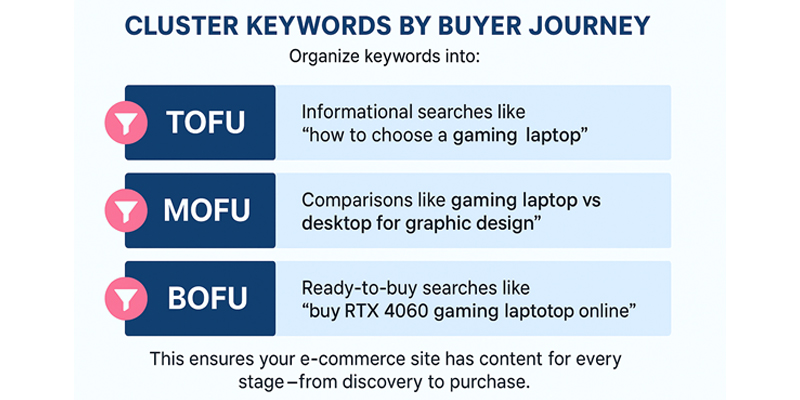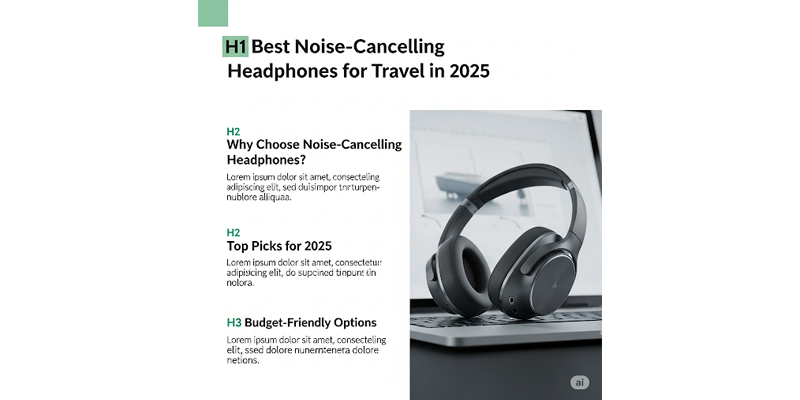

E-commerce SEO is the process of optimizing your online store so it appears higher in search engine results pages (SERPs) for keywords potential customers use when shopping online. This involves improving technical performance, site architecture, content relevance, and user experience to drive qualified organic traffic that converts into sales.
In 2025, the definition of e-commerce SEO has evolved far beyond simply ranking product pages. With AI-powered search engines and Generative Engine Optimization (GEO) shaping how results are displayed, online stores must now ensure their content is structured in a way that both search algorithms and AI assistants can understand, retrieve, and recommend.
Effective keyword research is the backbone of e-commerce SEO—especially in 2025, where AI-powered search engines don’t just match keywords, but interpret user intent to deliver precise, conversational answers. For online stores, this means identifying search terms that signal a high likelihood of purchase and structuring them in a way that AI assistants can easily understand and recommend.
Not all keywords bring sales. In AI Mode, you should prioritize transactional and commercial intent keywords—phrases that indicate a customer is ready to buy. Examples include:
These keywords often feature action words (buy, order, get, shop) or price filters (under ₹X, best for Y use case), making them valuable for both SERP and AI-driven recommendations.
AI search thrives on natural, conversational queries. Instead of targeting short keywords like “running shoes,” optimize for full questions or descriptive phrases such as:
These phrases align with how users speak to AI assistants and voice search devices.
Don’t limit keyword research to Google’s Keyword Planner. Pull insights from:
Organize keywords into:

This ensures your e-commerce site has content for every stage—from discovery to purchase.
It will also build on the fact that content is central to providing significant benefits in e-commerce SEO strategies. Sophisticated or complex product descriptions are not merely telegraphic, reiterating the features of the product, but more than telling a tale about a product that meets a certain need and can solve a certain problem. Building well-developed category pages containing relevant information strengthens your site’s credibility in a given topic. By the same token, posts in a blog, buying guides, and how-to articles can yield long-tail key phrases without implicitly misleading possible clients. Besides, content updates enhance the appeal of your site to visitors, as well as search engines, which translates into improved ranking on SERP and traffic.
In the modern world of integrated Internet commerce, it is necessary to know top e-commerce SEO strategies to become successful. Due to increasing numbers of retailers migrating to the online market, competition for visibility within the SERP has increased the need for proper e-commerce SEO services. In this guide, you’ll discover the key components of effective SEO for your online store to attract the right audience.
The e-commerce SEO strategies are aimed at enhancing the site’s performance in terms of attracting free, organic traffic. Organic traffic is far more valuable to a business compared to that of paid ad traffic the latter of which delivers value almost instantaneously, but stops once the cookies are cleared. Generally, e-commerce SEO strategies should be based on both a common understanding of search engine requirements and customer expectations to make propositions. Such a foundation creates a long-term basis for positive development and search visibility in a constantly growing number of competitors in the digital sphere.
Technical optimization of e-commerce is a frame of reference for all the other e-commerce SEO strategies. This is all about website speed, mobile legitimacy, and correct link structure within your website. This is because search engines are more likely to rank websites that prove to be user-friendly, technical optimizations are important for ranking. Moreover, the correct use of structured data in HTML tags allows search engines to take your products into deeper consideration with the possibility of improving the shown search snippets. A good technical concept is also understanding how to handle canonical tags to avoid problems with duplicate content and the utilization of XML sitemaps to get all critical pages indexed.

Any plan aimed at enhancing the rankings of an online business requires special attention to be paid to product page optimization. The website should be primarily built to display product pages each of which should have a proper title and meta description, high-quality image and appropriate image description, and a detailed product description. Adding user reviews not only establishes credibility but also delivers brand-new, pertinent content that search engines like Google often seek. It is always important to keep the hierarchical structure of your product categories clear for both the user and the search engine to follow if you want your site to perform well. However, introducing breadcrumb navigation is also recommended to improve the usability of a site and to positively affect the SEO results.
Many e-commerce websites do not pay much attention to internal links, even though internal links are vital both for users and for search engine optimization (SEO). Proper internal linking of related products, category pages, and informational content leads to the distribution of the page authority among your site and makes navigation approachable for your client. It also assists search engines to establish relations of different pages that are within your site. Internal linking is a crucial element of any website, and when employed strategically, can help with increasing crawl frequency and directing users through content they would find valuable as well as meaningful to search engine algorithms.
As the trend toward mobile sales remains in force, certain e-commerce SEO strategies focus on mobile-compatible approaches to SEO. This is more than what is considered as having a mobile-friendly layout – it entails having images optimized for mobile web, navigation that is friendly with touch devices, and a checkout process that is compatible with small screens. This aspect of SEO has become especially important to e-commerce companies since Google has shifted to mobile-first indexing. It is recommended to use structured data and AMP (Accelerated Mobile Pages) for critical landing Web page solutions to improve mobile results and the user experience.
Local SEO becomes part of the e-commerce SEO strategies when the e-commerce business has physical stores or outlets or where their business targets particular regions. This involves:
Making location-specific keywords;
Claiming and verifying business listings across the internet;
When appropriate, creating location-specific web pages.
Local SEO is an effective way to drive not only online conversions but also physical traffic to physical stores. Using specific data for local business information and constant and unchanging NAP data in every channel is the key that helps to develop local search ranks.

By including the concept of social proof in your e-commerce SEO, you can influence both the rank as well as the conversion of the business. Customer reviews, questions and answers, and user photos are only a few examples of fresh content that will be appreciated by search engines. This content also benefits the development of trust in the target consumer and can increase the click-through rates from advertisers. Regular production with a well-planned and controlled mechanism of discouraging/encouraging users to contribute content to a website is very useful in achieving continual SEO gains and improving the shopping experience for customers.
E-commerce SEO strategies should be religiously monitored and frequently modified to enhance their effectiveness. By using Google Analytics, Search Console tools can track organic traffic, conversion rate, and positions of keywords. The idea is to report and monitor those values frequently to uncover potential development opportunities. Always bear in mind that SEO is a continual process rather than a single, giant push. Quite simply, it is a good practice to set up regular audits of the SEO campaign and establish a testing regimen to make certain that the campaign remains relevant and optimized to current standards.
In order to achieve great results and become a leader in e-commerce SEO, one needs to apply an accurate and elaborate approach that is produced from technical SEO, good content, and a decent user experience for site guests. If you are persistent and work towards these goals while always analyzing results and making changes with the help of an SEO company in Bangalore, your online store will become more noticeable in search rankings and finally get more organic traffic. It is also important to note that e-commerce SEO does not yield results in a short time, and for this reason, every online business establishment should invest in it in the long run. Oh yes, search engines grow more complex every day, which means that if you are not up to date with the latest SEO tips and tricks, you’re e-commerce site might just be left behind in the dust.